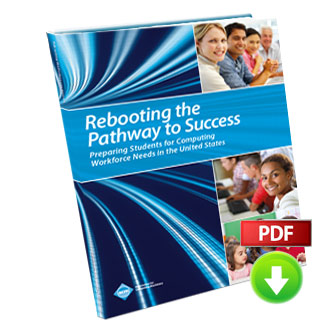Resources
Education Resources
This report demonstrates the process of qualifying to teach computer science can be difficult to discover and difficult to achieve. The report recommends clear, consistent, and attainable K-12 computer science teacher certification. The report provides state-by-state reports covering the variety of requirements for computer science teacher certification and computer science high school graduation requirements for students in the 50 states and the District of Columbia. The full-text of the report is available for download. The website also provides an interactive map of state reports.
These standards provide a framework for comprehensive integration of computer science into the primary and secondary curriculum. The standards provide a three-level framework for computer science education, including detailed learning outcomes, sample activities, and other resources to guide implementation. The standards are designed to strengthen computer science competency and fluency for all students and to provide clear education pathways for students with an interest in computing careers.
This report identified the numerous and significant gaps between state secondary education standards and nationally recognized computer science standards. It showed clearly that K-12 computer science curricular standards were not widely adopted, and that rigorous computer science courses rarely satisfied a core mathematics or science credit for high school graduation. The report provides state-by-state reports for the 50 states and the District of Columbia.
The College Board publishes reports and data for the AP exams administered each year. The annual AP Report to the Nation provides a high-level overview of the number of students taking AP exams. Program participation and performance data for the AP Computer Science A exam is available at the national level and by state. The first AP Computer Science Principles exam will be administered in May 2017.
Postsecondary ResourcesThis report provides an overview of data and trends in science and engineering education and workforce in the United States. The report also examines those trends in context of international developments, the economy, and investments in research and development. Chapter 2 on higher education addresses undergraduate, graduate, and doctoral enrollment and degrees.
This recommended computing curricula address core learning outcomes for undergraduate programs in computing. The report offers curricular and pedagogical guidance for educators at public and private universities and colleges.
This Special Report provides data on the participation of women, minorities, and people with disabilities in the science and engineering fields. Pre-generated tables and charts, available under the "Digest" tab, provide insight into undergraduate and graduate enrollments, employment status, and occupation.
IPEDS contains education data from colleges, universities, and technical and vocational institutions in the United States. The IPEDS Data Center allows users to explore pre-defined reports, generate custom reports, and download the results in a variety of formats for further analysis. The IPEDS Tables Library provides pre-generated tables that users can search by keywords or browse by data source, subject, release date, or popular topic.
Employment and Workforce Resources
The federal government publishes statistics on the number of jobs and salaries for computing occupations, nationwide and by state. To help policymakers, industry, and educators better prepare the pipeline of talent for future workforce needs, BLS provides employment projections for 10 years in the future.
This report provides an overview of data and trends in science and engineering education and workforce in the United States. The report also examines those trends in context of international developments, the economy, and investments in research and development. Chapter 3 on the labor force addresses the size, growth, market conditions, and demographics of the U.S. workforce. It also addresses women and minorities in science and engineering occupations.
This Special Report provides data on the participation of women, minorities, and people with disabilities in the science and engineering fields. Pre-generated tables and charts, available under the "Digest" tab, provide insight into undergraduate and graduate enrollments, employment status, and occupation.
This report found that to be competitive and successful in the 21st century, a country's workforce needs a solid education in the fundamentals of computer science and mathematics.


 Download the Report in PDF (4 MB)
Download the Report in PDF (4 MB)


